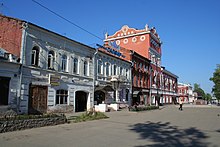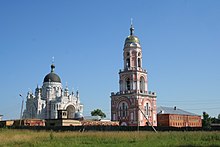Vyshny Volochok
| city
Vyshny Volochok
Вышний Волочёк
|
||||||||||||||||||||||||||||||||||||||||||
|
||||||||||||||||||||||||||||||||||||||||||
|
||||||||||||||||||||||||||||||||||||||||||
| List of cities in Russia | ||||||||||||||||||||||||||||||||||||||||||
Wyschni Wolotschok ( Russian Вышний Волочёк , DIN transliteration Vyšnij Voločëk ) is a Russian city with 52,370 inhabitants (as of October 14, 2010) in the Tver Oblast .
geography
Vyshny Volochok is located in the northwest of the European part of Russia, approximately halfway between Moscow (287 km away) and Saint Petersburg (365 km away) and 119 km northwest of the regional capital Tver .
It is embedded in a lake landscape of the northeastern Waldai heights and is located on a 109 km² reservoir of the Zna river from the Neva river system . Due to the large number of natural and artificial waters in and around Wyschni Wolotschok, the city is sometimes referred to as the "Russian Venice ". There are over 40 bridges in the city alone.
history
Wyschni Wolotschok was first mentioned in a document from 1437. At that time it belonged to the Novgorod Republic and was already on a road that connected its capital Novgorod with Moscow. The place name is of Russian origin and means something like "upper portage ", which indicates the corresponding location of the place on the Zna river, which once had many rapids in this area .
After difficult times in the 15th century, when Vyshny Volotschok was contested between rival Russian principalities and damaged several times, it came to the Grand Duchy of Moscow . In the 16th century the place was called Nikolski Pogost after the local church of St. Nicholas of Myra . At this time the area began to develop as a center of trade and handicrafts, which was due not least to the favorable location between Moscow and Petersburg and the formerly important trade route " from the Varangians to the Greeks ".
In the 18th century Vyshny Volotschok began to form in its partially preserved shape. The brisk growth of the place at that time can be traced back to the construction of a new road connection between the old and the new capital as well as to the construction of the first connecting canal between the river systems of the Volga and the Neva . The canal commissioned by Peter I was completed in 1722. From then on, shipbuilding and other industries and crafts flourished in Vyshny Volotschok.
In 1770 Vyshny Wolotschok received city rights and from 1775 belonged to the Tver Governorate . In the 19th century it was considered an important center of the textile industry and one of the richest cities in the north-west of the Russian Empire .
With the relocation of the St. Petersburg – Moscow railway through Vyshny Volotschok in 1849, it was one of the first Russian cities to receive a railway connection, but this drastically decreased the importance of the previously important canal. In this way, Vyshny Volotschok lost its former economic importance towards the beginning of the 20th century.
During the Soviet era , the city's artificial water system was renewed and expanded in the 1940s. The reservoir grew to its current size of 109 km² and has since been used for Moscow's water supply.
During and after the Second World War , Wyschni Wolotschok was home to the POW camp 216 for German prisoners of war . It was 7 km south of the city center near a canal. Again to the south of it there was a 2 hectare prisoner of war cemetery with a total of 2,000 dead, mainly in mass graves. The Leontjewo camp - most likely a sub-camp belonging to the main camp 216 - was located 10 km northwest of the city. The POW camp was managed by Camp Administration 384 , Kalinin (today's Tver ) in early 1948 .
The treatment of seriously ill people from the individual camps took place in the POW Hospital 3052 . It had a hospital cemetery where about 5000 deceased were buried. Hospital 1246 in Ostashkow was also responsible for medical care . The POW labor battalions No. 216/339 and 216/346 of the Red Army were also located in Vyshny Volotschok .
Population development
| year | Residents |
|---|---|
| 1897 | 16,612 |
| 1939 | 63,644 |
| 1959 | 66,360 |
| 1970 | 73,688 |
| 1979 | 71,703 |
| 1989 | 64,789 |
| 2002 | 56,405 |
| 2010 | 52,370 |
Note: census data
Partnerships
![]() Berettyóújfalu (Hungary)
Berettyóújfalu (Hungary)
Economy and Transport
Today Wyschni Wolotschok has a diverse industry with textile, wood, paper and food companies as well as some educational institutions.
The city lies on the Saint Petersburg – Moscow railway line and has a long-distance train station there. The parallel M10 road also runs through Wyschni Wolotschok.
sons and daughters of the town
- Pyotr Anjou (1796–1869), navigator and polar explorer
- Anton Stuckenberg (1816–1887), traffic engineer and writer
- Iwan Wyschnegradski (1832–1895), engineer, scientist and university professor
- Alexander Stuckenberg (1844–1905), geologist, paleontologist and university lecturer
- Sergei Kussewizki (1874–1951), Russian-American conductor and double bass player
- Alexandra Artjuchina (1889–1969), party and state functionary
- Ekaterina Furzewa (1910–1974), politician
- Boris Sokolow (1914–2013), geologist, paleontologist and university lecturer
- Lidija Franklin (1917–2019), dancer, dance teacher and choreographer
- Oleg Sorochtin (1927-2010), geologist
- Yuri Borissow (* 1956), politician and deputy defense minister
Individual evidence
- ↑ a b Itogi Vserossijskoj perepisi naselenija 2010 goda. Tom 1. Čislennostʹ i razmeščenie naselenija (Results of the All-Russian Census 2010. Volume 1. Number and distribution of the population). Tables 5 , pp. 12-209; 11 , pp. 312–979 (download from the website of the Federal Service for State Statistics of the Russian Federation)
- ↑ Page no longer available , search in web archives: Article Russian Venice on tverskaya-gubernia.ru (Russian); Reviewed on November 24, 2012
- ↑ Maschke, Erich (ed.): On the history of the German prisoners of war of the Second World War. Verlag Ernst and Werner Gieseking, Bielefeld 1962–1977.
Web links
- Official Website (Russian)
- Vyshny Volotschok on mojgorod.ru (Russian)







